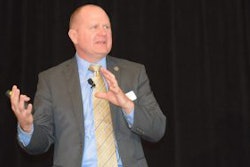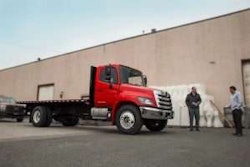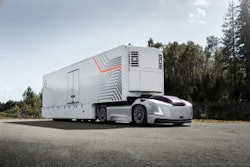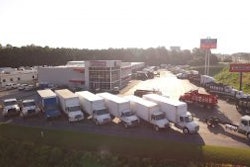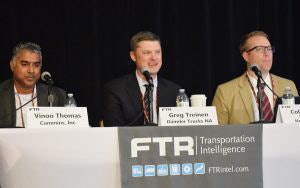 Panelists from left: Vinoo Thomas, Cummins; Greg Treinen, Daimler Trucks North America; Collin Shaw, WABCO.
Panelists from left: Vinoo Thomas, Cummins; Greg Treinen, Daimler Trucks North America; Collin Shaw, WABCO.With an autonomous and electrified trucking industry seemingly nigh, legacy trucking OEs and suppliers made it known Thursday that it’s not just industry upstarts who are developing the tech behind the industry’s future. What’s more, they said, their longtime relationships with fleets is the linchpin in deploying and refining autonomous and electric systems.
Representatives from Daimler Trucks (maker of Freightliner, Western Star and Detroit), Cummins and WABCO spoke in a panel titled “New Technologies Revolutionizing Commercial Vehicles” at the FTR Conference in Indianapolis. Panelists included Vinoo Thomas, director of product planning for Cummins; Greg Treinen, sales and marketing manager for Daimler Trucks North America’s advanced technology division; and Collin Shaw, product marketing leader for WABCO.
The discussions were broad, not focusing on too many specifics of the development of autonomous and electric trucks. But both automation and electrification are on the horizon, perhaps a near-term horizon, panelists said.
Deployment of the systems will be measured, however, and fleet testing is needed to refine the underlying elements of each major technology set, they said.
Daimler is slated to deliver a handful of electric trucks to fleets late this year, says Treinen, to “see how these vehicles will operate in their business, whether they fit, what charging time needs are, where they need to place the infrastructure,” he says.
“Fleets are going to start adopting [electric trucks] and we’re going to learn together,” says Shaw. “Before there’s mass adoption, we have to get the product to a state where [fleets] can adopt it in mass. There are unknowns out there that we don’t know about yet.”
Questions about standardizing charging ports and charging infrastructure still loom large, however. Thomas called electric energy storage the “800-pound gorilla” of electric vehicles, relative to both off-vehicle power storage and on-vehicle batteries. “What are you going to do to balance out the weight” of batteries, he said. “There are significant challenges in the base technology.”
Treinen said he hopes to see manufacturers and other suppliers work together to produce standardized charging ports so that “a competitor isn’t using one standard of charging port and we’re using another and the customer has a mixed fleet.”
“We want to make sure we’re all working together as an industry to create a uniform [standard],” he said.
Electric trucks present a host of new challenges for suppliers like WABCO, Shaw said. When the industry was eyeing natural gas as an alternative to diesel a half-decade ago, existing WABCO systems like braking and air generation only needed small adjustments from diesel-powered trucks to those running natural gas. “Electrification of the industry [presents] a fun issue,” he said. “The fundamentals of how we work are going to change a little bit.”
Braking system requirements, for instance, will be much different for electric vehicles, due to the regenerative braking (a form of kinetic energy storage) needs. Electric vehicles “[present] a unique opportunity for us to change up how the braking system works,” he said. Likewise, air generation will need to be evaluated. “You have this very quiet electric vehicle, do you want a noisy compressor? How do you generate air in a manner that’s acceptable to the driver and the fleet? How do we generate air through various portions of the vehicle? And where does the air go?”
Thomas says the hardware challenges likely will be easier to solve than the software challenges. There will be “so many smart systems on vehicles,” he said, noting the “critical aspect” for “these subsystems to be able to talk and integrate.”
The data produced by these smart systems, however, will reap big rewards for OEs and truck owners. “The ability to amass a big amount of data and do some analytics and to add value to the user will be there very early on,” he says. “Any electric provider expects the experience to be much better than it was with conventional products,” he said, referring to the implementation of existing telematics systems.
Both Shaw and Treinin pointed to adoption rates of safety tech over the last decade as evidence for fleets’ thirst to put such technology into service, even if they’re hesitant when the technology is first introduced. For example, Treinen said take rates of Detroit’s collision avoidance system, Detroit Assurance, have soared to more than 70 percent — from about 25 percent — in only a few years.
Deploying platooning systems is as a stepping stone to fully autonomous trucks, said Shaw. Though platooning offers certain “operational efficiencies” to fleets, he said, “What it helps us as an industry do is start introducing” automated systems. “It helps us introduce vehicle communication, helps us to develop protocols so vehicles can talk to each other and eventually talk to infrastructure,” he said. “The platooning conversation is important even if some fleets are skeptical. Mass deployment won’t happen for a bit, but it’s important to keep the discussion going because it helps us deploy the next steps [of autonomy]. It helps us bridge the gap [to Level] 4 and 5 autonomous driving.”

